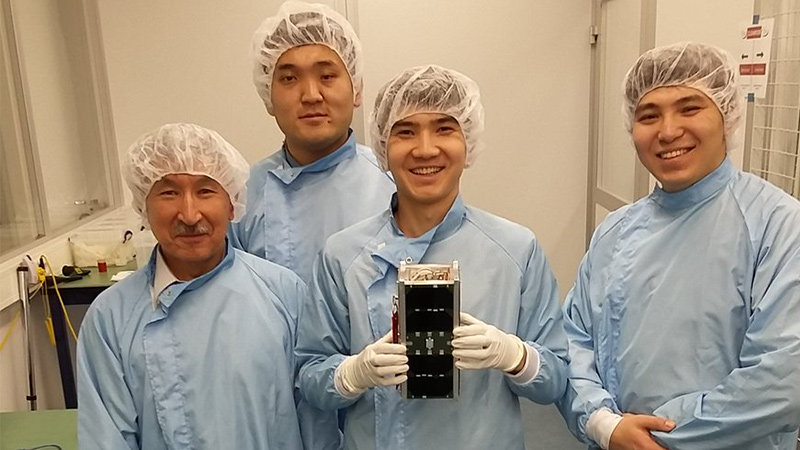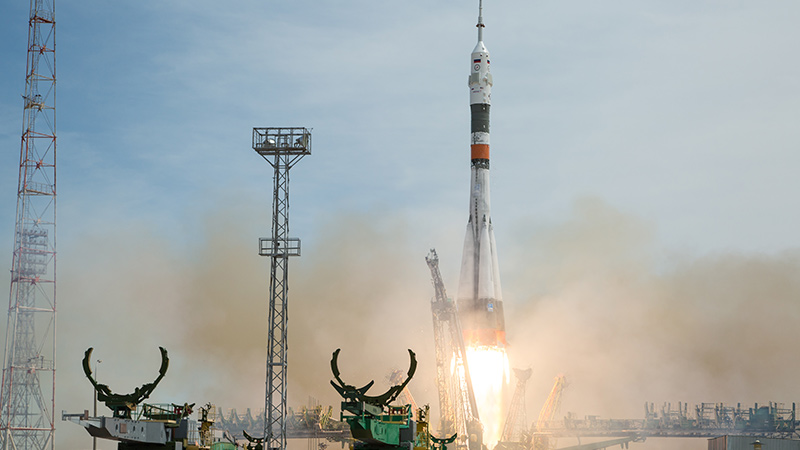Stay Up to Date
Submit your email address to receive the latest industry and Aerospace America news.
A look at the country's developing aerospace industry
The former Soviet republic faces some daunting economic challenges, due partly to the effects of sanctions on its trading partner, Russia. On a July visit, former Pentagon official Amanda Simpson found a country determined to carve a place for itself among the world-leading aerospace nations.
Which country hosts the most human space launches and recoveries? As surprising as it might be, the answer is the Republic of Kazakhstan in Central Asia. The country that takes pride as the region where horses were domesticated five thousand years ago now has aspirations to soar ahead in the aerospace field, far beyond its leasing of the Baikonur Cosmodrome launch complex to neighboring Russia and providing its northern steppes as a landing zone for returning Soyuz capsules.
Starting from the remains of a superpower has been and will continue to be a technical and economic challenge. Kazakhstan is undertaking this post-Soviet modernizing without distancing itself from that Soviet heritage. Kazakhstan, in fact, held onto its status as a Soviet Socialist Republic until just 10 days before the Soviet Union disbanded in December 1991. President Nursultan Nazarbayev was picked by the Soviet Union in 1989 to lead the Communist Party in Kazakhstan, elected president after independence and most recently re-elected in 2015 with almost 98 percent of the vote, according to news accounts.
I visited Kazakhstan in late July as a guest of the U.S. Embassy. I was there to participate in forums organized around the future energy-themed Expo 2017 being held in the capital city of Astana. As a recognized expert in the operational reliability of energy systems and use of large renewable energy projects, I attended meetings the embassy arranged to advise Kazakhstan government and industry leadership. I also have experience in aerospace and my remaining schedule was filled with meetings with members of the aerospace sector. I was struck by the country’s determination to expand its space enterprises as part of its post-Soviet-era modernization.
Kazakhstan owns two telecommunications satellites and controls its two Earth observation satellites, all of which were built by European companies. The national space company, Kazakhstan Gharysh Sapary or KGS for short, is developing a complex for indigenous satellite design, construction and testing. KGS is also installing a ground station for a differential navigation system that will receive and analyze signals from the U.S. GPS constellation, the European Galileo satellites and the Russian GLONASS (Global Navigation Satellite System) spacecraft, and transmit accuracy corrections nationwide. KGS also plans to build on its astrophysical experience to produce aerospace materials that can meet U.S. and European standards. It plans to build a defense industry around armored vehicles, munitions and high-altitude unmanned air vehicles.
Kazakhstan’s plans in space
Like all space-faring nations, Kazakhstan has learned to persevere in the face of failures. Control of the country’s first communications satellite, KazSat-1, built by Moscow-based Khrunichev Space Center in cooperation with Thales Alenia Space and launched in mid-2006, was lost in mid-2008, according to news reports. The next two spacecraft, KazSat-2 and KazSat-3 (launched in 2011 and 2014), are providing telecommunications, television broadcasting and high-speed internet access in Kazakhstan and its neighboring countries.
I had an opportunity to meet with the KGS leadership, including president Yergazy Nurgalyev. He discussed the company’s plans for long-term industrial programs in the field of space activity, and he presented plans for establishing the complex in Astana for satellite design, assembly and testing. Already operating at the complex is a control center for the two Earth observation satellites in orbit. KazEOSat-1 and KazEOSat-2 are multispectral imaging spacecraft built by what was then known as EADS Astrium, now part of Astrium Defence and Space. KazEOSat-1 provides 1-meter resolution imagery and KazEOSat-2 provides 6-meter resolution. Islam Sakirov, the lead specialist at the KGS International Cooperation Office, explained that while the citizens and customers in Kazakhstan have first rights to decide where these satellites point their cameras, the country has partner agreements for imagery distribution with 10 other countries that fall under the orbits. Additionally, imagery from other areas along the orbital track is available for purchase from KGS. Data is disseminated within Kazakhstan for monitoring agricultural, geological and mineral resources as well as natural hazards. KGS indicated that the Kazakhstan government has an interest in building a National Spatial Digital Infrastructure and reaching out to the region to encourage the same.
KGS and the U.S. Geological Survey have also teamed up at times. In 2015, they co-hosted a regional Central Asia workshop on Earth Remote Sensing as applied to integrated water resource management. This workshop highlighted KGS’ ambition to become a regional center for remote sensing. USGS has also helped KGS calibrate sensors on the KazEOSats and is advising on the development of Kazakhstan’s National Spatial Data Infrastructure.
KGS is finishing development of the differential navigation stations, and plans to expand the system to include China’s Compass satellite system, said cosmonaut and Kazakhstan national hero Aidyn Aimbetov, KGS vice president for space technology. There will be numerous local stations, plus a high-power shore-based marine station deployed to cover the Caspian Sea.
Kazakhstan’s first indigenously produced satellite was launched in February from India. Al-Farabi-1 is a 2-unit cubesat built by students at the Al-Farabi Kazakh National University in Almaty. The 10-by-10-by-20-centimeter satellite is the product of an educational mission to develop and test components manufactured in Kazakhstan. The National Center for Space Research and Technology has produced a 3U cubesat to study the Earth’s magnetic field. This vehicle was designed and built without any foreign assistance and is scheduled for launch atop a Falcon 9 in February 2018, according to Marat Ismailov, director of the national center’s Material Science and Space Instrumentation Department. The center also is working with KGS to develop a radar imaging satellite to complement the nation’s electro-optical spacecraft. This vehicle is targeted for launch in 2024.
At Kazakhstan’s largest city, Almaty, I met with the center’s leadership. They outlined some of their ambitious plans to advance the country’s aerospace and defense industry. Center president Chingis Omarov explained that to spur investment and international cooperation, his organization is focusing on supporting the design and development of armored vehicles, munitions and unmanned air vehicles. The initial challenge will be to replace the Soviet-era machine tools and equipment still in use throughout the country. Ismailov has a goal of creating products that meet U.S. and European standards. His current emphasis is on carbon plastics and insulating films. Assylkhan Bibossinov, director of the Aerospace and Astrophysical Institute, sees solar powered air vehicles as more versatile than satellites. With 30 percent to 40 percent efficient panels and batteries that come in at 400 watts per kilogram, he anticipates that Kazakhstan industry can develop an aircraft that can operate for months or years at altitudes of about 100,000 feet.
The future of the Baikonur Cosmodrome also seems secure. Kazakhstan and Russia started the Baiterek Project in 2004 as a joint venture to modernize the facility and assure continued use through 2050. The project includes modifying Kazakhstan-owned and -operated launch facilities starting in 2018 for the new Phoenix carrier rocket to be launched beginning in 2025, and expansion of joint operations at the Proton and other launch facilities. While Russia says it plans to launch from the Vostochny Cosmodrome within its own borders, construction issues and financial restrictions continue to delay completion. Even so, Russian reliance on Baikonur will keep Kazakhstan involved in launch operations for many decades to come.
Inhibiting nuclear proliferation
After the Soviet Union broke up, Kazakhstan temporarily inherited the nuclear weapons and facilities in its territory. This, for a time, made it the fourth largest nuclear power and owner of the Semipalatinsk Test Site, where the Soviet Union conducted 456 nuclear explosions between 1949 and 1989. In 1994, a covert operation by the governments of Kazakhstan and the United States dismantled the nuclear weapons, removed materials and closed the test site.
Project Sapphire, as it is known, secured and removed 600 kilograms of weapons-grade enriched uranium that was stored in Kazakhstan to fuel Russian Alfa class submarines. The U.S. and allies in Europe and Asia created the intergovernmental International Science and Technology Center in Kazakhstan to employ Russian nuclear engineers and scientists and inhibit proliferation of their knowledge. Today, this center pursues seismic and radiological research along with bio-security, water-security, and other chemical, biological, radiological, and nuclear transportation safety and security issues, said David Cleave, the executive director. This research is primarily funded by the U.S. Department of Energy and the European Union. These projects are serving as pathfinders and are leading to similar efforts throughout Central Asia to employ ex-Soviet engineers.
Fiscal challenges
Kazakhstan is rich in resources that are the engine of its economy. It is the world’s leading exporter of uranium. Crude oil and natural gas are exported to Russia and the eastern portions of Europe, accounting for 20 percent of its gross domestic product, 50 percent of its revenue and 60 percent of its exports. But the protracted decline in global oil prices has severely impacted the funds available to support industrial and aerospace development. The World Bank reports that Kazakhstan saw a 4.1 percent decrease in its gross domestic product in 2014 and further decreases in 2015 and 2016. Low oil prices and sanctions against the country’s largest trading partner, Russia, impacted exports, which fell 40 percent in the first half of 2015. This had a direct effect on the currency, which devalued 26 percent in 2015 after falling 19 percent in 2014. Today, inflation stands at an average rate of 14.6 percent. However, with an anticipated increase in crude oil prices over the next few years and increased production with new fields coming on line, the Kazakhstan economy is expected to grow by as much as 2.9 percent per year over the next three years.
It takes a lot for an economy to transform itself from a supplier of raw materials to an exporter of ideas, science, and technological advancement. The people of Kazakhstan are proud of their achievements in space with large sections of their National Museum and Expo pavilion celebrating past successes and prospective opportunities. Their government and industry stand committed to making space a large part of their future. I wish them well.
Editor’s note: In the NASA photo at the top of this page, a Soyuz rocket is rolled out by train to the launch pad at the Baikonur Cosmodrome in Kazakhstan.
Amanda Simpson was U.S. deputy assistant secretary of defense for operational energy from September 2015 to January 2017, and worked in the aerospace and defense industries for 35 years as a program manager and test pilot. She is an AIAA associate fellow.
Related Posts
Stay Up to Date
Submit your email address to receive the latest industry and Aerospace America news.







